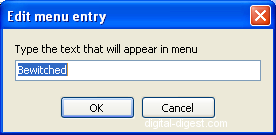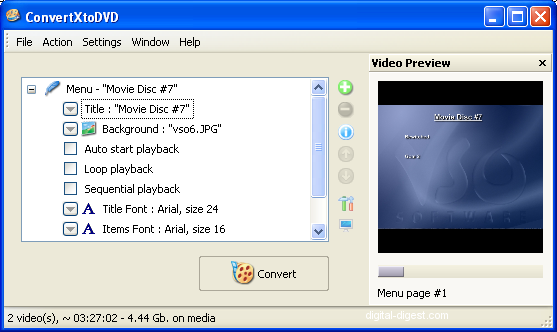Video to DVD Conversion Using ConvertXtoDVDOriginal Page URL: https://www.digital-digest.com/articles/Video_to_DVD_Using_ConvertXtoDVD_page1.htmlAuthor/Publisher: DVDGuy Date Added: Jun 21, 2007 Date Updated: Jun 21, 2007 Continuing in our series of video to DVD conversion and authoring guides, we take a look at ConvertXtoDVD, a commercial software but one that is quite popular. ConvertXtoDVD, like the name suggests, will take in almost all video files and then produce a DVD for you. Unlike DVD Flick, ConvertXtoDVD can create a basic menu for you. ConvertXtoDVD has a built-in burner, but if you prefer not to use it and to test playback first prior to burning, then a DVD folder output is available (this guide will not cover burning DVD folders, but links to instructions will be provided). The DVDs ConvertXtoDVD produces supports simple functions such as subtitles, audio tracks and chapters, with a very simple menu. If you want fancy 3D menus, chapter menus, audio/video setup screens and even the ability to create easter eggs, then you should try other software such as Nero Vision or TMPGEnc DVD Author. Read our DVD Authoring Tools Roundup to find out which DVD authoring tool is best for your needs. Software you'll need: Hardware you'll need:
Step 1: InstallationInstallation is easy, just run the installer and follow the instructions. Before we start loading in our video files to make the DVD, we should examine our input files to see what kind they are (PAL or NTSC). Step 2: InputsBefore you load your inputs into ConvertXToDVD, it is best to make sure that these input files are all of the same system (PAL or NTSC or NTSC-Film). As a rule, files that are 23.976, 24, 29.97 or 30 frame per second are NTSC. While PAL video is at 25 FPS. Multiples of these frame rates (eg. 15 FPS and 60 FPS => NTSC) are sometime used as well. There are many ways to check for the frame rate of your video file, for example, using GSpot for AVI files. In fact, ConvertXtoDVD will tell you the frame rate when you load in the video file, but as with the DVD Flick guide, I prefer to organise my videos before even starting ConvertXtoDVD, so I will know beforehand what kind of DVD I am making. Normally, your video player software will also show you the frame rate of the file. For example, in Windows Media Player, you can find out the frame rate of the video by accessing the "Statistics" options from the "View" menu, go to the "Advanced" tab and the "frame rate" will be displayed there.   If you are using Media Player Classic, you can find out the frame rate by going to the "File" menu, selecting "Properties", go to the "Details" tab and the FPS will be shown there (the screenshot below shows: "Video: MPEG4 Video (H264) 720x384 25.00fps [Video]").  Once you have found out the frame rates of your video files, separate the NTSC and PAL ones, as you do not want to mix them together when making a single DVD. You should probably also separate the widescreen and full-frame videos. So each DVD you make should only contain widescreen PAL, widescreen NTSC, full-frame PAL or full-frame NTSC content. It's also probably a good idea now to check your input video to see if they have any audio synch issues, and fix them before loading them into ConvertXtoDVD. Step 3: ConvertXtoDVD SettingsStart ConvertXtoDVD. The first thing we will do is to set up the project, so click on the "Settings" menu and select "General".  Nothing really important to set up here in the General section. The only thing you might want to change is the working folder, where the output DVD files and any temporary files will be located - the default is the "ConvertXtoDVD" folder under your "My Documents". Moving on to the "Chapters" tab, here you can specify the automatic chapter creation options. You can tell ConvertXtoDVD to insert chapters every X number of minutes if the video is longer than Y minutes. The default options (create a chapter every 5 minutes if the video file is longer than 15 minutes) seem to be fine.  To the "Menu" tab now, here are some interesting settings. First, think about whether you want menus at all - menus are great if you have multiple video files, but if you only have one video file, you probably don't need a menu. Select the "Include Menu" option if you want menus. Going through the other options:
 To the "TV Format" tab next. This is where the work we did in "Step 2" comes into it - here you can manually specify the system (PAL or NTSC) and the aspect ratio (4:3 full-frame or 16:9 widescreen), or leave it on "Automatic" for ConvertXtoDVD to sort out. If all your input files are of the same system and aspect ratio, then leaving it on "Automatic" will work fine. If you have mixed inputs (again, not recommended - you might get jerky video playback, or video that is of the wrong aspect ratio), then you can force on of these settings.  Click on the "Burning" tab. Here, you can specify the burning options for ConvertXtoDVD. If you've read my other DVD authoring guides, you know that I don't like to burn straight to disc, as I prefer to test the authored DVD before burning. Uncheck the "Burn result to DVD" if you feel the same way, or otherwise insert a blank disc into your DVD writer drive now, check the "Burn result to DVD" option and set a burning speed (as a general tip, burn at 4x or below to minimize the chance of a bad burn). The "Add original files to DVD (if possible)" options is an interesting one - if you have enough space on the disc, ConvertXtoDVD will add the original input files onto the DVD (these will only playable on your PC). The "Delete folder after successful burn" will delete the output DVD folder once burning is completed - uncheck this if you plan on making more copies later on. "Send burning statistics to VSO online database" can be selected to help VSO compile stats about what kind of media is being used, how successful it is at burning, burning speeds ... uncheck if you are a privacy nut (no personal information is sent anyway). The "Do not eject ..." option is fairly obvious. The "Prefer SAO burning mode for DVD-R" enables "Session-At-Once" burning mode - some DVD burners have problems with SAO, while others will only work with it - leave it unchecked unless you do have problems with burning.  On to the "Subtitles" section. Here, you can specify the default subtitle language and whether the default subtitles will be shown automatically without specifically turning it on in the menu. If you click on the "Text subtitles rendering settings", you can specify how the subtitles will look like on screen.   Go to the "Audio" section. Just like subtitles, select a default audio language if you need to and/or set it to be automatically enabled (if you have more than one audio track). You can also let ConvertXtoDVD adjust the audio level to increase/decrease loudness. The "Don't check/fix audio discontinuities" option is best left unchecked unless you get audio synch issues after making the DVD (another reason to not burn to disc straight away).  Click on the "Encoding" tab. Here is where you specify how ConvertXtoDVD will convert your input video files into DVD compatible MPEG-2 files. Select the "log engine messages" if you need to, for troubleshooting/debugging reasons. Select the quality/speed of the encoding - unless you are really strapped for time, select "High quality/Slow encoding". "Target size" is obvious, and conversion priority can be changed if you plan on doing work while encoding happens in the background ("Normal" will give the program equal status as other programs - so both might be slow if they are used at the same time. Selecting "Below Normal" will always give preference to your current active program).  Finally, onto the "Image processing" tab. There is only one option here, and that is to apply de-interleave/de-interlace to your input video. Normally, you would not need to do this, as most video files you have are progressively encoded. The only exception is DV footage or certain type of interlaced HDTV recordings. Press "OK" to close the settings window and return to ConvertXtoDVD.  Step 4: Adding TitlesOk, use the  You can expand the "Audio" listing to enable/disable audio tracks to be included on the DVD. You can right click on the "Subtitle stream" listing and add a subtitle for the file - supported subtitle formats include idx, sub, srt, ssa and ass. You can right click on the "Chapter" listing and add new chapter stops, or expand the chapter listing and edit any of the automatically created chapter stops. Double click on the "Menu text:" option to change the name of this video track (that will be displayed on the track select menu).  Expand the "Source details" to see the details of your input file - here you can see the frame rate like I described earlier. Finally, expand "Image processing" to access the option to fit the video to screen (might make widescreen video look a too tall - this option is good if you have full-frame video that isn't exactly 4:3 in ratio). The De-interleave option can be selected here just like in the "Settings" menu (don't select it unless your source if interleaved/interlaced - as explained previously, most videos don't need this enabled, except for video from a DV source or certain types of HDTV recordings). Now load in all your video files. You can use the up and down arrows to change the playback order. When you are done, expand the "Menu" item.  First, change the title of the DVD to something less generic than "My DVD". You can then change the background of the menu. The menu options found in "Settings -> Menu" are available here as well (see Step 3 for an explanation of these options). A preview of how the menu will look can be seen on the right hand side. All that is left to do is to click on the "Convert" button, and ConvertXtoDVD will start it's work and produce a DVD for you. This could take a while, possibly as long as the lengths of the movies themselves. After ConvertXtoDVD finishes, you will either have a newly burnt DVD (if you selected to burn straight to disc option), or you will have a DVD folder (complete with VIDEO_TS folder, IFO, BUP and VOB files) ready for testing and burning. You can test playback in PowerDVD or another software DVD player, and if you are happy with the results, burn to DVD using ImgBurn, using our Burning a DVD Folder with ImgBurn guide if you wish. And we're done Got more questions? Post them in our ConvertXtoDVD Forum and get them answered by other expert users. |
 button to load in your video files one by one. After loading a video file, the video file will be added to the list on the left hand side (and if you selected to use menus, a menu item is also added to the top of this list). You can expand the title to show the audio/video/chapters and other information for this track.
button to load in your video files one by one. After loading a video file, the video file will be added to the list on the left hand side (and if you selected to use menus, a menu item is also added to the top of this list). You can expand the title to show the audio/video/chapters and other information for this track.